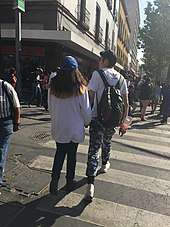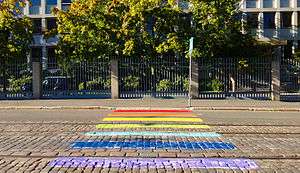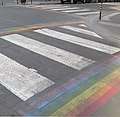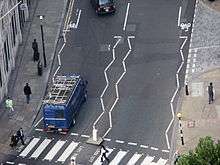Zebra crossing
A zebra crossing is a type of pedestrian crossing used in many places around the world. Its distinguishing feature is alternating dark and light stripes on the road surface, resembling the coat of a zebra. A zebra crossing typically gives priority to pedestrians.



Characteristics
The crossing is characterised by longitudinal stripes on the road, parallel to the flow of the traffic, alternately a light colour and a dark one. The similarity of these markings to those of a zebra give the crossing's name. The light colour is usually white and the dark colour may be painted – in which case black is typical – or left unpainted if the road surface itself is dark. The stripes are typically 40–60 cm (16–24 in) wide.
In the United Kingdom the crossing is marked with Belisha beacons, flashing amber globes on black and white posts on each side of the road, named after Leslie Hore-Belisha, the Minister of Transport, who introduced them in 1934. Pedestrians have a right of way when they step onto the crossing: The Highway Code states that road traffic "MUST give way when a pedestrian has moved onto a crossing."[1]
In other countries, such as the United States, zebra crossings are also used on pedestrian crossings controlled by traffic signals.[2]
History
Pedestrian crossings (later called Zebra crossings after stripes were added) were originally introduced in law in Britain by section 18 of the Road Traffic Act 1934.[3]
Although the origin of the Zebra title is disputed, it is generally attributed to British MP James Callaghan who, in 1948, visited the country's Transport and Road Research Laboratory which was working on a new idea for safe pedestrian crossings. On being shown a black and white design, Callaghan is said to have remarked that it resembled a zebra.[4]
After isolated experiments, the zebra crossing was first used at 1,000 sites in the United Kingdom in 1949 in its original form of alternating strips of blue and yellow.[5][6] They were introduced nationally in 1951.
In 1971, the Green Cross Code was introduced to teach children safer crossing habits, replacing the earlier "kerb drill".
Line marking machine
The lines of a zebra crossing are commonly laid down by a road marking machine. Because the width of crossing lines is wider than other traffic lines, the marking shoe of a zebra cross marking machine is accordingly wider. The machine is hand pushed.[7]
Regional variations
In the United Kingdom, lollipop men or women (school crossing patrols) frequently attend zebra crossings near schools, at the hours when schoolchildren arrive and leave. Their widely used nickname arose because of the warning sign they hold up as they stop traffic: the sign is a large round disc on a long pole and thus resembles a giant lollipop, although they were originally of a square design.
In Germany, Scandinavia, and most other European countries, pedestrians have right of way if they are still on the curb but about to enter the zebra crossing.

In North America, zebra crossings are almost exclusively called crosswalks. Zebra crossings are widely used in the United States and are the preferred variation of the many crosswalk marking styles. In most areas of Canada, parallel line markings is the preferred marking style, except in Toronto where zebra markings are widely used.
In New Zealand, motorists are required to give way to pedestrians. Pedestrians wishing to cross the road within 20 m (66 ft) of a crossing facility (which includes zebra crossings) must use a crossing facility.[8]
In Australia, raised zebra crossings are sometimes called wombat crossings.[9]
A 1998 Swedish study by A Várhelyi at Lund University found that the frequency of giving way at zebra crossings was 5% and drivers typically did not observe the law concerning speed behaviour at the zebra crossing. Speed behaviour in encounters (148 observations), non-encounters with pedestrian presence (642 observations) and situations without pedestrian presence (690 observations) were compared.
Three out of four drivers maintained the same speed or accelerated and only one out of four slowed down or braked. The study concluded that encounters between cars and pedestrians at the zebra crossing were critical situations in which the driver had to be influenced before he reached the decision zone at 50 to 80 m (160 to 260 ft) before the zebra crossing, in order to prevent "signalling by speed" behaviour.[10]
In Switzerland yellow stripes are used for pedestrian crossings. Unlike a yellow tiger crossing in the UK, however, cyclists are required to dismount to cross.
In Lebanon, zebra crossings are the preferred pedestrian crossing type, though many other variations exist, such as the parallel cat's eye lines. Zebra crossings are painted at mostly all intersections and they provide priority and right of way to pedestrians under all circumstances.
In the United Kingdom
In the United Kingdom, it is the law that all road users, including motorists, give way to pedestrians at zebra crossings (Rule 195 of The Highway Code). They were introduced in the late 1940s and 1950s to tackle high death rates of pedestrians crossing roads. For over 60 years they have been recognized as a safe place for pedestrians to cross but more recently, some drivers are failing to give way to pedestrians. It is believed that hundreds of people have died at the crossings and thousands more have been injured. This has prompted some councils to install enforcement cameras at the crossings to catch offenders.
In the United Kingdom, a fine of £100 and three licence penalty points is given to those failing to give way at the crossings. Such a penalty has attracted criticisms of leniency when compared to other countries which enforce fines of up to £2,000.[11] For failing to give way at a zebra crossing patrolled by a school crossing patrol ("lollipop man/lady" as they are commonly called), however, the penalty rises to £1,000 and a minimum of three licence points, with the possibility even of disqualification.[12] In the United Kingdom, motorists have to stop for a crossing patrol, even when it is not on a pedestrian crossing.[13][14]
Cow crossing
The city of A Coruña in Galicia, Spain has opted for spots rather than stripes at a pedestrian crossing, resembling a cow instead of a zebra. The reason for this option is to recognize the importance of the animal for the region's farming.[15]
Tiger crossing
A tiger crossing is a variation used in Hong Kong and the United Kingdom. It is painted yellow and black. In the United Kingdom, it allows cyclists to cross in a central area of the road without dismounting, and obliges motorists to give way to both cyclists and pedestrians. Aylesbury, Buckinghamshire experimented with tiger crossings during 2006–2007, but replaced them with toucan crossings.[16] A tiger crossing was introduced in Portsmouth in 2019.[17]
"Three-dimensional" crossings
A number of countries have experimented with "three-dimensional" zebra crossings based on an optical illusion. The white stripes of the crossing appear to hover above the ground as though they were a physical barrier. Although intended to improve pedestrian safety on the crossings, they have also been popular with tourists who like to be photographed crossing them, appearing to hover above the ground. Such crossings can be found in Australia, Iceland, Malaysia, India, New Zealand and the United States.[18]
In popular culture
A zebra crossing appears on the cover of The Beatles' Abbey Road album. The cover made the crossing a tourist attraction, and it has been incorporated into the Abbey Road Studios logo. Since the Abbey Road photo was taken, zigzag lines at the kerb and in the centre of the road have been added to all zebra crossings. The band Shriekback's album Sacred City contains an entire song, "Beatles Zebra Crossing?", about the Abbey Road zebra crossing and its status as a tourist attraction. English Heritage has given this crossing Grade II listed building status.[19]
There is also a tongue-in-cheek reference to zebra crossings in the science-fiction comedy The Hitchhiker's Guide to the Galaxy by English author Douglas Adams, in reference to Man using the improbable creature called the Babel fish as proof of the non-existence of God; the novel says, "Man then goes on to prove that black is white and gets himself killed at the next zebra crossing."
The La Paz traffic zebras is a team of young people who dress in zebra costumes and dance in the streets of La Paz, Bolivia in order to make drivers and pedestrians aware of traffic rules.
Rainbow zebra crossings
A zebra crossing immediately outside the Russian Embassy in Helsinki was painted in summer 2013 with the colours of the rainbow to protest the Russian government's policy towards lesbian and gay people, the rainbow being one symbol of the LGBT culture.[20]
A similar protest has also been made on a zebra crossing near the Russian Embassy in Stockholm, Sweden.[21]
In 2018 in Paris, the authorities decided to paint some crossings with rainbow borders for the Pride; those were supposed to be temporary, but after homophobic vandalism, the municipality declared that the rainbow stripes would remain permanently.[22][23] In the Sydney suburb of Darlinghurst there was a rainbow crossing along Oxford street in recent years, to show support for the LGBT community.
Gallery
 Yellow zebra crossing in Switzerland.
Yellow zebra crossing in Switzerland. A zebra crossing outside the Russian Embassy, Helsinki painted with a rainbow.
A zebra crossing outside the Russian Embassy, Helsinki painted with a rainbow. A rainbow zebra crossing in Paris, July 2018.
A rainbow zebra crossing in Paris, July 2018. These zigzag lines indicate to United Kingdom motorists that they are approaching a pedestrian crossing.
These zigzag lines indicate to United Kingdom motorists that they are approaching a pedestrian crossing.
References
Notes
- "Using the road - Pedestrian crossings (191 to 199)". The Highway Code. Archived from the original on 2017-11-10. Retrieved 10 November 2017.
- "Regeln am Fussgängerstreifen" [Rules on the pedestrian stripe] (in German). Touring Club Schweiz. Archived from the original on 2017-11-11. Retrieved 2017-11-10.
- "Road Traffic Act, 1934" (PDF). Archived (PDF) from the original on 2016-10-25. Retrieved 25 October 2018.
- Country, Black (26 November 2009). "All aboard the road to safety". Black Country Bugle. Archived from the original on 2014-08-20. Retrieved 19 August 2014.
- Archives, The National. "Public Information Films - 1945 to 1951 - Pedestrian Crossing". www.nationalarchives.gov.uk. Archived from the original on 2018-10-11. Retrieved 24 October 2018.
- "All liked "Zebra" crossings". The Argus (Melbourne) (32, 344). Victoria, Australia. 2 May 1950. p. 6. Retrieved 25 October 2018 – via National Library of Australia.
- "DY-HPTP Hand-push Thermoplastic Screeding Pedestrian Road Marking Machine". Archived from the original on 2014-09-12. Retrieved 2014-09-28.
- Auckland Transport. "Pedestrian crossings". Auckland Transport. Retrieved 2016-04-07.
- "Crossings". The Driver's Handbook. Government of South Australia. Archived from the original on 2017-08-11. Retrieved 11 August 2017.
- Várhelyi, A. (1998). "Drivers' speed behaviour at a zebra crossing: A case study". Accident Analysis and Prevention. 30 (6): 731–43. doi:10.1016/S0001-4575(98)00026-8. PMID 9805516.
- Millward, David (22 October 2008). "Zebra crossing road deaths treble". Telegraph. Archived from the original on 2017-04-11. Retrieved 2018-04-05.
- Road Safety Wales (2010-03-04). "School Crossing Patrol – News". Roadsafetywales.co.uk. Archived from the original on 2014-10-06. Retrieved 2014-08-19.
- Qureshi, Yakub (2013-12-18). "Annalise Holt death: Oldham schoolgirl aged 12 who died after being hit by a van at zebra crossing named by police". Mirror Online. Archived from the original on 2014-10-06. Retrieved 2014-08-19.
- "Lollipop women and men in the firing line". Southern Daily Echo. 2012-05-21. Archived from the original on 2014-10-06. Retrieved 2014-08-19.
- Pontevedra, Silvia R. (2018-08-30). "Dear dairy: Galicia ditches zebras for cows at a city crosswalk". El País. ISSN 1134-6582. Archived from the original on 2018-08-30. Retrieved 2018-08-30.
- Buckinghamshire County Council (2006). "Aylesbury hub Cabinet report". honestjohn.co.uk. Archived from the original (http) on February 17, 2012. Retrieved October 11, 2007.
- Melton, Byron (13 February 2019). "This busy road will close as Portsmouth's first 'tiger crossing' is installed – and independent firms say their trade will take a hit". The News. Portsmouth. Retrieved 12 May 2019.
- Bhole, Aneeta (29 May 2018). "Outback town takes a 3D approach to slowing motorists at pedestrian crossings". ABC News. Archived from the original on 29 May 2018. Retrieved 30 May 2018.
- "Beatles' Abbey Road zebra crossing given listed status". BBC Online. 22 December 2010. Archived from the original on 30 December 2010. Retrieved 2015-03-08.
- "Rainbow zebra crossing protest at Russian embassy". Yle Uutiset. Archived from the original on 2018-07-28. Retrieved 2018-07-27.
- "Crosswalk at Russian Embassy in Sweden Painted Rainbow Colors in Protest of Anti-Gay Laws: PHOTO - Towleroad Gay News". Towleroad Gay News. 2013-08-11. Archived from the original on 2018-07-28. Retrieved 2018-07-27.
- BFMTV. "Les passages piétons arc-en-ciel à nouveau vandalisés à Paris". BFMTV (in French). Archived from the original on 2018-06-29. Retrieved 2018-07-27.
- BFMTV. "Des passages piétons aux couleurs LGBT seront permanents à Paris". BFMTV (in French). Archived from the original on 2018-06-28. Retrieved 2018-07-27.
Sources
| Wikimedia Commons has media related to Zebra crossings. |
- History of Road Safety, Gerald Cummins
- The History of British Roadsigns